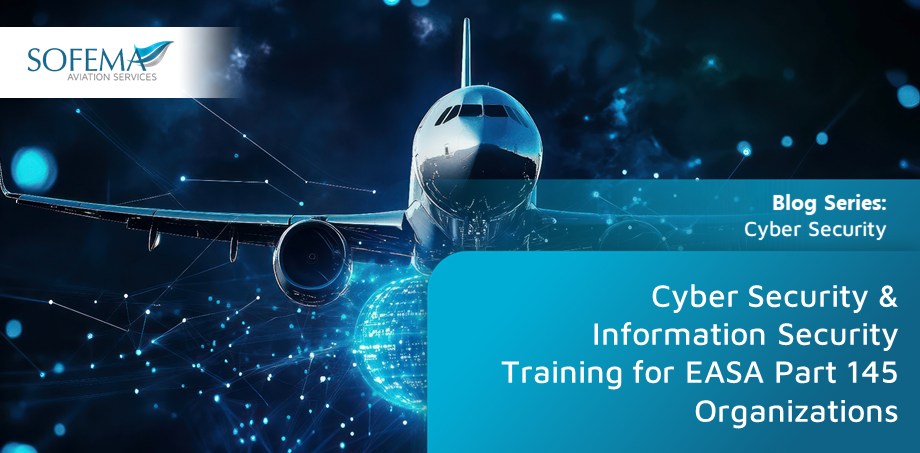Sofema Online (SOL) considers the training requirements to support EASA Part 145 Organizations in respect of Information and Cyber Security
Introduction to the Primary Objective – Ensure all levels of staff understand their roles and responsibilities in managing cyber security risks in compliance with Regulation (EU) 2023/203.
Accountable Executive & Leadership Team (C-Level)
Duration: 1 Day (Executive Briefing) Target Audience: Accountable Managers, Directors, C-Suite Executives
Key Learning Objectives:
- Strategic Understanding of Regulation (EU) 2023/203
- Overview of compliance requirements for EASA Part 145 organizations.
- Deadline for implementation (February 2026) and strategic planning.
- Cyber Security Risk Management at the Executive Level
- Risk-based decision-making aligned with safety and operational priorities.
- Integration of cyber security into the Safety Management System (SMS).
- Incident Response and Leadership Roles
- Executive responsibilities in a cyber incident.
- Internal and external reporting obligations.
- Resource Allocation & Compliance Oversight
- Ensuring adequate funding and personnel for cyber security.
- Role of the leadership team in governance and policy enforcement.
Delivery Method: Executive Workshop with case studies & strategic discussions.
Senior Managers (Department Heads, Compliance, Quality & Safety Managers)
Duration: 2 Days Target Audience: Quality Managers, Compliance Managers, CAMO Managers, IT Managers
Key Learning Objectives:
- Regulatory Deep Dive: Compliance with (EU) 2023/203
- Requirements for Information Security Management System (ISMS).
- EASA expectations and oversight mechanisms.
- Risk Assessment & Cyber Security Strategy
- Identifying, assessing, and mitigating risks.
- Supply chain risk management and vendor assessment.
- Developing an Information Security Management System (ISMS)
- Implementing policies and procedures.
- Role of management in monitoring and continuous improvement.
- Cyber Incident Response Planning
- Internal & external reporting (IS.I.OR.230).
- Crisis communication & business continuity planning.
- Audits & Continuous Improvement
- Compliance monitoring and internal audits.
- Oversight responsibilities of senior management.
Delivery Method: Combination of lectures, workshops, and interactive case studies.
Supervisory Staff (Line Managers, Maintenance Leads, IT Security Coordinators)
Duration: 1.5 Days Target Audience: Maintenance Supervisors, IT Coordinators, Operational Team Leads
Key Learning Objectives:
- Practical Implementation of Cyber Security Measures
- Understanding cyber threats in maintenance environments.
- Compliance with IS.I.OR.240 (Personnel awareness & responsibility).
- Identifying and Responding to Cyber Threats
- Recognizing potential threats (ransomware, phishing, insider risks).
- Immediate actions required when a threat is detected.
- Safe Handling of Digital Maintenance Records
- Protecting maintenance software from cyber threats.
- Ensuring system integrity & unauthorized access prevention.
- Supply Chain & Third-Party Risk Awareness
- Managing supplier risks & compliance with security requirements.
- Verifying third-party cyber security measures.
- Role in Incident Response & Reporting
- Escalation procedures and communication with senior management.
- Contributing to post-incident analysis and corrective actions.
Delivery Method: Hands-on workshops, role-playing exercises, scenario-based training.
Frontline Staff (Technicians, Engineers, Admin, General Employees)
Duration: 1 Day Target Audience: Engineers, Maintenance Technicians, Admin & Support Staff
Key Learning Objectives:
- Cyber Security Awareness & Best Practices
- Understanding common cyber threats in the aviation maintenance industry.
- Recognizing phishing emails, malware, and social engineering.
- Secure Work Practices
- Handling sensitive maintenance data safely.
- Importance of password security and access control.
- Incident Identification & Reporting
- What to do in case of suspected cyber threats.
- Reporting procedures and escalation channels.
- Compliance with Organizational Cyber Policies
- Understanding internal security policies and personal responsibilities.
- The role of individuals in ensuring compliance with (EU) 2023/203.
- Basic Cyber Hygiene in Daily Operations
- Using secure networks, avoiding unauthorized software, and recognizing suspicious activities.
Delivery Method: E-learning modules, practical demonstrations, awareness campaigns.
Next Steps
- Follow this link to our Library to find & download related documents for Free.
- See the following 2 day course-Implementing an Information Cyber Security Program in an EASA Part 145 Organization – 2 Days
for comments or questions please email team@sassofia.com
Tags:
Cyber Incident Response Planning, Frontline Staff, secure networks, Cyber Policies, Secure Work Practices, Cyber Security Awareness, Maintenance Technicians, security requirements, Managing supplier risks, IT Security Coordinators, EASA Part 145, C-Suite Executives, Leadership Roles, Cyber Security Risk Management, Regulation (EU) 2023/203, BlogSeries, SAS blogs, Cyber Security, Accountable Managers





